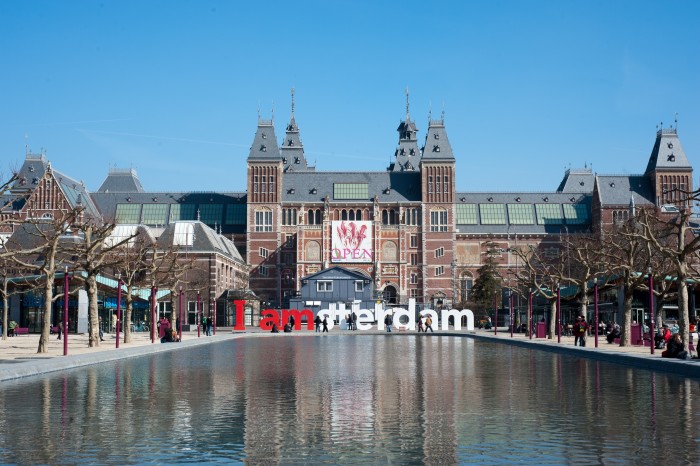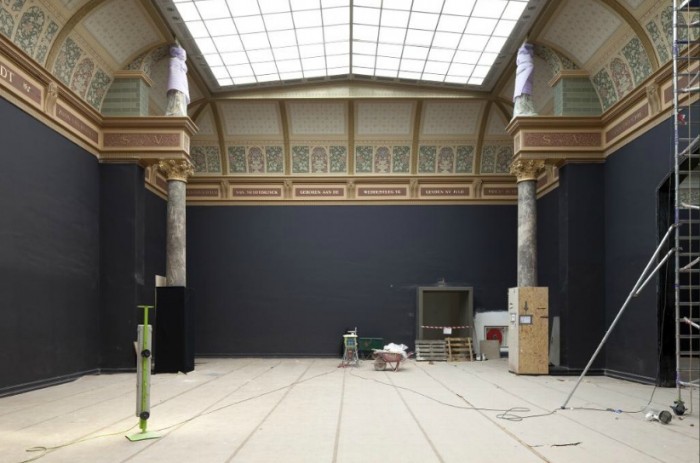From nos.nl, 2 September 2012
The Rijksmuseum in Amsterdam will re-open for the general public on 14 April next year. The day before, on Saturday 13 April the completely refurbished museum will be opened festively.
In the renewed museum a permanent collection of 8.000 objects will be on view, that tell the story of the Netherlands from the Middle Ages until now. Currently the objects are moved back into the museum. In the new museum different types of objects from the same period are displayed together.
Next year in March the last piece, Rembrandt’s Nightwatch will return to it’s old spot. The Rijksmuseum, after re-opening, will be the first National Museum in the world to be open 365 days a year.
From the museum website, 2 September 2012
The Rijksmuseum itself has existed for more than 200 years. It has been housed in the current building designed by architect Pierre Cuypers (1827-1921) since 1885. Viewed from the historic city centre, the museum is imposing and severe looking, viewed from the Museumplein, however, it looks like a fairy-tale castle. After more than a hundred years of intensive use, this enormous building was due for a fundamental makeover. In 2000, the Dutch government at the time decided to make this a reality and, following a long preparatory phase, the construction works are now in full swing. They will ensure that this internationally renown museum meets the standards of the present day.
The architects had the following challenge: strip the building of its later additions, ensure that it is once again a coherent whole and restore Cuypers’ clear layout. The design combines the grandeur that defines the Rijksmuseum, plus facilities such as a museum café, a shop and, to preserve the art, climate-control and security features which are completely in line with today’s requirements. In a few years’ time, visitors will be setting foot not in a renovated museum, but in a completely new museum.
Cruz y Ortiz’ solutions
The head architects for the renovation are Antonio Cruz and Antonio Ortiz from Sevilla, Spain. Cruz y Ortiz were chosen by a committee chaired by the chief government architect for their purist view of architecture and their excellent solutions to the architectural and logistic challenges involved in this project. According to their design, the two inner courtyards which were added in the post-war years will be broken open, creating a two-part atrium linked by the passageway, which will be open as before.
The Asian Pavilion, where the small but beautiful Asiatic collection of the Rijksmuseum will be housed, is also new. The Pavilion, which can be clearly seen from Museumstraat, is surrounded by water. The natural-stone and glass façade contrasts with the red bricks of the main building. In the garden, opposite the Pavilion, are the Cuypers Villa and the Teekenschool. Between these, Cruz y Ortiz placed a small new building – the new service entrance, offering access to the museum via an underground passage.
Cuypers’ hallmark
Pierre Cuypers’ 1885 masterpiece is a monument as well as a museum building. The motto is therefore “continue with Cuypers”. Cuypers’ clear layout will be restored wherever possible. The monumental ornaments will also be returned to the Gallery of Honour, the Front Hall, the Night Watch Gallery and the stairwells. Cuypers’ hallmark is best preserved in the library where the original design and ornaments have largely been maintained.
Museum content: what will be displayed where?
Only The Night Watch by Rembrandt van Rijn will remain in its old position, at the centre of the building.
> The new Rijksmuseum will offer visitors an overview of art and history from the late Middle Ages to the present day. Paintings, images, historical objects and applied arts will be displayed together in context, offering a comprehensive image of art and culture, with – as can only be expected – particular attention paid to the highlights of the story of the Netherlands. The museum has chosen the motto ‘a feel for beauty, a sense of time’ for this new setting.
When viewing the Netherlands, it is essential to do so in an international context. The Dutch have travelled far and wide to explore all corners of the world and in the course of the centuries, many people have come to the Netherlands from elsewhere. The Netherlands has always been a crossroads and that is also evident in the new layout.
In a wing fitted out specially for the purpose, the Rijksmuseum will display its Special Collections. Large sub-collections will be on display here, including porcelain, silver, jewellery, glass and ceramics, in staggering numbers, as well as both simple and elaborately decorated weapons and an exciting collection of model ships.
The academic library, the Prints and Drawings Department and the Teekenschool (Drawing School) make the museum complete. There is something for everyone in the new museum – from researchers to those who are setting foot in the Rijksmuseum for the first time.
Interior design: the work of Jean-Michel Wilmotte
Paris museological designer Wilmotte, famous for the interior of Musée du Louvre, among others, was asked to furnish the Rijksmuseum galleries. Wilmotte has designed display cases, ornament lighting and plinths which fit in naturally with the old building. In consultation with Cruz y Ortiz, Wilmotte also determines the interior colour scheme, in which he was inspired by the Cuypers’ palette. Wilmotte ensures the past and present come together in a unique manner in the Rijksmuseum’s architecture.
Facts and figures
The new Rijksmuseum will display around 7,500 works of art and historical objects, which is almost the same amount as before the renovations. The walking distance through the 80 galleries at the museum, taking in the exhibition areas is a total of around 1.5 km.
The entire Rijksmuseum collection, including drawings, prints and photos, consists of around 900,000 items. Before the renovations, around 1,200,000 people visited the Rijksmuseum annually.
The museum will have the capacity to welcome between 1.5 – 2.0 million visitors each year.


